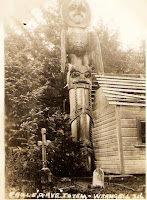THE MAN WHO MARRIED A TREE
The following piece is a work of fiction, though it's based upon the real story of John Muir's infamous bonfire in an October storm. I grew up on the hill Muir wrote about in Travels in Alaska. My favorite spot on Mount Dewey was also Muir's favorite spot. My grandfather ended up homesteading on the acreage below the small hill. One of the things I wanted to answer was: Why did Muir build the bonfire? Sure Muir said he wanted to see how the trees would act in a storm, but I didn't think that was a good enough answer. So I made one up. Here's to John Muir. Here's to adventure. Here's to loving a tree.

I made short excursions to the nearby forests...causing wondering speculation among the Wrangell folk.-- John Muir,Travels in Alaska.

I made short excursions to the nearby forests...causing wondering speculation among the Wrangell folk.-- John Muir,Travels in Alaska.
October 1879
John Muir kneeled in the grass near the Presbyterian Church counting tree
rings. Missionary Young recently cut down the large spruce to make way for the
new manse. In his notebook Muir recorded dendro-memory, layers of wood-cells.
The old tree had chronicled rain, temperature, and wind velocity for over a
hundred years.
Soon
Muir became aware of Wrangell-folk peeking out their doors at him. By
mid-day locals gathered to watch the strange man talk to himself. From behind
him someone said, “There’s an even bigger live
tree up the hill.” Muir turned and saw a local Tlingit, Old Town Slim, pointing
his wide hand beyond the steeple. “I’d guess he'd be over two-hundred-years
old,” Slim said.
 |
| My husband, a tree hugger |
Muir found the large
tree near the edge of a clearing. He circled the tree, running his hand along its
bark noting the dragon-like scales. Suddenly, he had an urge to hug the tree.
“May I,” he asked, reaching his lanky arms around, leaning in, his cheek pressing
its scratchy hide—rough like whiskers,
he thought. He closed his eyes, inhaling its wet scent. He stepped back and
poked his finger into the pitch globbing from beneath the bark. He sniffed it,
then stuck his finger in his mouth sucking the sticky substance.
For two more weeks Muir
visited this tree, discovering its inner stratum. He learned to strip a small
tree root and made nettle tea. He even climbed to a top branch, straddled its
knobby arm to look out over Zimovia Strait to snow-capped Woronofski Island.
One night Muir settled
beneath a bark shed, covering himself with his blanket. The tree sheltered him
as he dreamed of his youth: skinny dipping with his friend Scott in Blossom
Lake. Afterwards, they'd lay naked, drying on the rocks. But one day, Scott
brought the girl who lived on the neighboring farm to swim—after that, Muir never
went swimming at the lake.
 |
| Fort Stikine (Wrangell, Alaska) |
Now,
Muir slept late and awoke beneath the great spruce, its erect pendant cones
dangling, its female cones swelling purple. He felt the pith at his center, the
xylem, his cambium layer. He got up and ate hardtack crackers, listening
to the tree moan its stories. The tree told of first contact with whites,
Russian rule, explorers and gold seekers. Near nightfall, the winds gusted and branches snapped. “Storm coming,” Muir
said. Since he'd first stepped off the
boat in Alaska and discovered the spruce and hemlock forests, he sensed a
change—a celebration was needed. “A marriage, yes,” he said to the tree.
Muir dragged dead
branches and dry grass to the center of the clearing and built a small fire. He
added more tree limbs until the fire roared. The large spruce dropped pine cones at his feet and he tossed them into
the fire. The sky darkened and it started to pour. Around him, the
forest creaked; sparks danced like
crazed fireflies. He wiped tree-pitch on his face, his lips, then stomped
around the fire, arms twirling. He kept heaping branches on the fire until his
skin flushed with heat.
Below the storm-dance, Missionary
Young awakened to the rap of frightened Tlingits at his door. He looked up at
the glowing hill—St. Elmo’s Fire? A madman perhaps? Then Young remembered the
strange Mr. Muir, wandering around town mumbling to himself. Such actions, he figured, likely meant that Muir was
smitten with a local girl. Yes, he chuckled looking up at the sky-fire, lances
of gold aurora streaking upward—a madman indeed.
* There is a Tlingit story called The Woman Who Married a Tree (Tlingit Myths & Texts, J. Swanton).



Comments